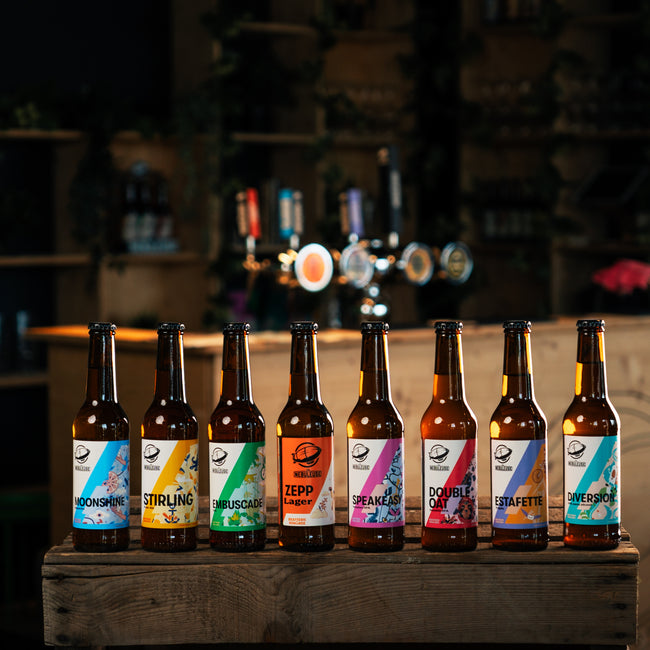Winter beers warm up your evenings

Ah, winter... That season when even the most ardent patio-goer finally admits that drinking outside isn't really an option anymore. It's time to trade in those summery Session IPAs for more comforting companions. Because while winter has its flaws—no one ever truly enjoys scraping their windshield at 7 a.m.—it at least has the merit of being the ideal season to explore fuller-bodied, more complex beers —in short, those that require you to take your time.
The secrets of beers that warm the soul
The alchemy of roasted grains and winter spices
Roasted malts are a bit like those sweaters you pull out when the temperature drops: a seasonal staple that instantly warms you up. But behind this simple analogy lies real science. Roasting malts, a process that can reach temperatures up to 230°C, triggers what's known as the Maillard reaction—the same phenomenon that gives bread crusts and grilled steaks their flavor. This complex chemical reaction produces hundreds of different flavor compounds , including melanoidins, responsible for caramel flavors, and pyrazines, which contribute the roasted coffee notes found in stouts.
Take Malt Capone, for example. This 9% (alc. vol.) Pecan Stout is the kind of beer that perfectly exemplifies this mastery of the roasting process. Its complex blend of malts, including roasted barley and roasted rye, creates a deep aromatic base upon which notes of pecan, vanilla, and chocolate are grafted. The roast level of each malt is carefully calculated to achieve a balance between toasted flavors and sweeter notes, thus avoiding the pitfall of excessive bitterness that can sometimes develop with heavily roasted malts.
The Science of Winter Fermentation
The production of winter beers hides another technical peculiarity: their fermentation . With musts denser in fermentable sugars, the yeasts must work harder and for longer. This prolonged fermentation, often maintained at slightly higher temperatures than normal, allows the development of complex esters that contribute those characteristic fruity notes. It's a bit like letting a dish simmer for hours: patience allows the flavors to fully develop.
The magic of comforting aromas
Tasting a winter beer is an exercise in patience and discovery. The initial notes are often dominated by volatile compounds from roasted malts: coffee esters, chocolate aldehydes, and caramelized ketones. Then come the more subtle compounds: spicy phenols, fruity esters, and sometimes even tertiary notes developed during aging, such as aromas of leather or precious wood.
The art of tasting when the mercury drops
The service ritual: temperature and patience
First myth to debunk: no, a winter beer should not be served as cold as your ex. Serving temperature plays a crucial role in the perception of aromas. At too low a temperature, the volatile compounds responsible for aromas remain trapped in the solution. This is explained by basic physics: the higher the temperature, the more volatile the aromatic compounds become. The ideal range is between 12 and 14°C , where thermal agitation is sufficient to release the aromas without causing overly rapid oxidation.
Estafette , a 7 % Belgian Triple (alc. vol.), perfectly illustrates this principle. Its fermentation with WLP 530 yeast, renowned for its production of fruity esters, requires this optimal serving temperature to reveal its full aromatic complexity. The banana and apricot esters, produced during fermentation, then intermingle with the malty and spicy notes, creating a complete taste experience.
The art of progressive tasting
Tasting a winter beer is like a three-act reading. The initial nose, dominated by the most volatile compounds, opens with aromas of roasted malts. As the beer allows itself to express itself, fruity esters and more complex phenolic compounds gradually emerge. On the palate, the rising temperature unlocks new aromatic dimensions, while the warmth of the alcohol helps diffuse the flavorful compounds.
The Science of Food and Beer Pairings
The harmony of complex flavors
Winter beers are particularly adept at pairing food with beer thanks to their aromatic complexity. Double Oat , with its silky texture from oat and wheat flakes, creates fascinating molecular bonds with the fats of mature cheeses. Its tropical notes of mango and pineapple, from Mosaïc hops, contrast with the richness of winter dishes while complementing them.
The agreements operate on three basic principles:
- Complementarity: flavors complement each other
- Contrast: Opposite characteristics are highlighted
- Intensity: the balance between the strength of the dish and that of the beer
The alchemy of temperatures
Serving temperature also plays a crucial role in pairings. A winter beer served at the right temperature (12-14°C) naturally pairs with hot dishes, creating a thermal balance that promotes the release of flavors on both sides. Roasted malts develop compounds similar to those found in braised meats (products of the Maillard reaction), creating natural flavor bridges.
An invitation to discovery
Winter is ultimately the perfect season to explore the complexity of characterful beers. It's the time when the chemistry of roasted malts, the patience of fermentation, and the art of tasting come together to create unique taste experiences.
These beers remind us that sometimes, cold weather can be good: it encourages us to take the time to appreciate more complex brews, to understand the science behind their development, and to create shared moments that warm us more surely than a space heater. And that's still more rewarding than having to check the pressure on our snow tires.









